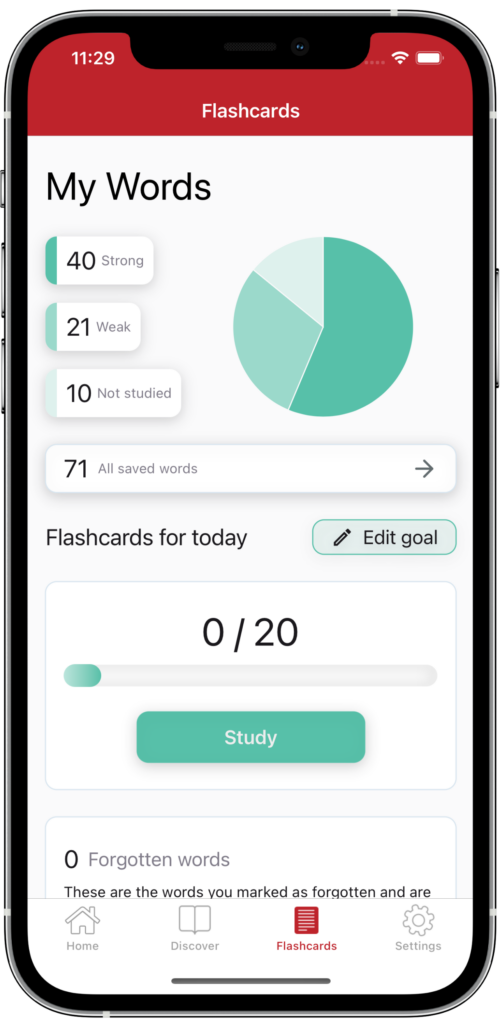The Best Way to Use Flashcards to Study Chinese
The Value of Flashcards
How do you use flashcards to study Chinese? Flashcards are an essential tool for language learners at any stage. They provide an effective way to stay organized while navigating the complexities of the Chinese language. With flashcards, you can track new vocabulary words and reinforce what you’ve already learned.
When it comes to using flashcards to study Chinese, they can significantly enhance your mastery of vocabulary and idioms (成语). By regularly reviewing and practicing with flashcards, you can reinforce your understanding and retention of these Chinese vocabulary words, characters, and phrases.
In this blog, we’ll explore how to make the most of both the flashcards feature in Du Chinese and the power of flashcards for studying Chinese to enhance your learning experience.
Step 1: Saving Words
The first step towards getting a rhythm started with flashcards is to keep track of words and phrases that you’d like to review. Here are some suggestions for casting a wide net!
Keeping track as you read
One good way to make sure you are exposed to fresh vocabulary is to read Chinese at your level. Du Chinese offers thousands of articles across various HSK levels, making it easy to find content that suits your needs. Ideally, aim to read lessons that are mostly understandable, with only a few new words, to minimize your reliance on the built-in dictionary. For an in-depth guide on how to pick reading material that meets your learning needs, check out our guide here!

Our writers and teachers have carefully written our stories and courses to gradually introduce and reinforce new and challenging vocabulary, promoting retention and long-term memory. By engaging with content that is appropriately challenging, you’ll learn new vocabulary in context, helping you retain vocabulary faster and more efficiently.
Regardless of what you’re reading, you’ll get the most out of it by keeping track of new words! In Du Chinese, you can easily save new or unfamiliar words to the built-in SRS flashcards, which helps reinforce your learning. While it might be tempting to save every new character you encounter, it’s more efficient to prioritize words that seem particularly useful or important. Verbs, adjectives, and common nouns are what to look out for, while things like hyper-specific place names or the titles of niche historical novels might not make the cut.
Step 2: Further analysis
There’s a lot of depth to Chinese. It might be worth considering reviewing things beyond just individual words. Here are some suggestions for how to break down aspects of the language into more manageable pieces!
Levels of analysis
Level 1: Short phrases, Idioms
Chinese is full of idioms (成语) and short phrases (短语) that are likely to pop up in writing or conversation. It can be tricky to master these phrases, so they might be worth reviewing as their own category. Also, short phrases can be considered the biggest “chunk” of the language that’s worth reviewing.
Level 2: Words
If short phrases are our largest category of language to deal with, then words would come next! As we mentioned, it’s important to be selective when saving words. Look out for words that strike you as particularly useful to avoid filling your flashcards with words you might not use very often.
Level 3: Characters
Because Chinese words are often composed of more than one character, sometimes it’s necessary to break them down a step further and look up what the characters mean individually. This can be incredibly useful, mainly because characters will often reappear in combination with others to form different words with similar meanings.
Level 4: Radicals
Finally, if you see a component crop up time and time again across different characters, that might be a radical worth paying attention to! Radicals are the smallest piece of the puzzle worth keeping track of, but knowing your radicals can make learning Chinese much easier, so don’t overlook them! Follow our radical series on Instagram to learn about specific radicals.
Step 3: Getting the most out of them

Reviewing your cards
While there’s no wrong way to review flashcards, here’s our personal suggestion!
Pick a certain number of cards
It’s best to limit the amount of cards you study to a fixed amount. Say, for example, you’ve made or saved 200 flashcards, you might want to start with just 20! By limiting the amount of cards you’re working through at any given time, you minimize the risk of overworking yourself and will better manage your time. With Du Chinese, you can set the number of flashcards you want to review each day, which you can adjust based on how much time you want to spend reviewing and how you want to approach your learning.
Review every day, divide and conquer
Start by trying to review your flashcards daily. Over time, you might find that some become easier to remember than others. Our SRS (Spaced Repetition System) will do this for you, so all you have to do when you see a flashcard is mark how well you remembered each word.
- Swipe Left or tap “Forgot” if you’ve forgotten the word
- Swipe Right or tap “Got it” if you remember the word
- Tap “Almost” if you recall only partial knowledge, such as knowing the meaning, but forgetting the pinyin or vice versa
Once you start to get in the rhythm of things, our flashcard system will automatically show you your weaker cards more, and your memorized cards less, allowing you to progress through your cards efficiently and in a way that makes sense.

If you’d like to focus solely on the vocab words you’re weakest with, you can also test yourself on “forgotten” cards for a more focused approach and more thorough review!
The key thing that makes flashcards effective is consistency! It’s better to review a few cards for a few minutes a day than it would be to review 200 of them all at once, once a week. Try out this process and see how it works for you!
Exporting Cards
Du Chinese will do the work of keeping all your saved words in one place and managing how you review them, but if you’d like to maximize efficiency and stay organized, you can use our Export feature to send your flashcards to Anki or Pleco. Here, you can make decks based on the different layers that we mentioned earlier (short phrase, word, character), by topic, or another category of your choosing.
Du Chinese has you covered
If you’re looking to streamline the reading and flashcard process, you can get it all in one place through our integrated flashcard system. Create an account to save words as you go when reading with Du Chinese, then let our in-app flashcards take care of organization with our spaced repetition system.
Regardless of how exactly you tackle flashcards, they can only help further your language learning goals. Hopefully some of our suggestions will be of use to you! Remember that consistency is key!







